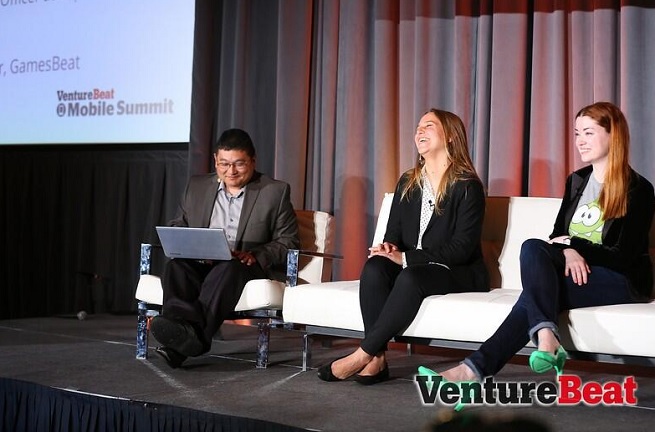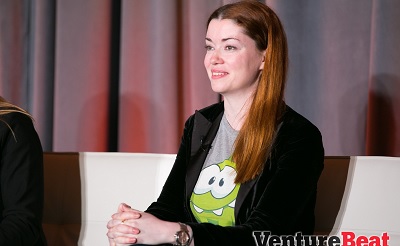You have the option of going to Facebook and figuring out exactly your audience and targeting with data, or you have the option of finding a brand that’s the perfect partner and doing that deal.
GamesBeat: There are some limitations here. We can’t be entirely cheerleaders for games. Some things have not set the world on fire, like the gamification of things like the enterprise. That’s not necessarily living up to the expectations people attached to it. What would you say to people who are skeptical that there’s anything relevant, something that games can teach?
Alegre: One thing I would do is just use the numbers that show the size of gaming. Apple paid $10 billion to developers this year, twice what they paid the previous year. That’s only half the market, because Android is by many metrics bigger than iOS. Of that money, more than half of it is spent on games. Gaming has been the first industry to figure out how to build a business on mobile.
As for gamification, yes, the word has been overused, but there are many examples of nongaming businesses taking things from gaming. We were talking earlier about how Microsoft’s Siri competitor, their personal assistant, they’ve used a voice from [the hit sci-fi shooter series] Halo, their top game, to engage with consumers.
GamesBeat: Yeah, the Cortana character.
Alegre: Another good example is how the App Store on the iPhone, it creates the same experience when you’re buying hardware as when you’re buying an in-app purchase. You’re pressing the same kinds of buttons when you buy a 99 cent virtual good as when you’re buying a $2,000 computer. They’ve taken that interaction with the user from gaming, from the App Store, and applied it to e-commerce. Suddenly they’re selling hardware.
Moldavsky: The numbers definitely speak louder than words. Right now, we have just under two billion smartphone users around the world. It’ll reach five billion in the next few years. Today, about 85 percent of time spent on mobile is spent with apps, and the biggest category among apps is gaming. To make a comparison, the next-biggest category as far as time spent is Facebook. That gives you an idea of how big gaming is and how much can be done there as far as reaching the consumer – every day, in their own time, through their device. You can create a meaningful connection with the consumer.
GamesBeat: What would, say, supermarket chain Safeway learn from games?
Alegre: A Safeway app — well, like I was saying before, when I go grocery shopping, I need to be able to get what I want in that first minute there. They need to deliver that instant gratification. They need to give me a reason to come back.
Apps like Instacart have figured out how to sell groceries through smartphones. Instacart is helping me figure out what I need in real time, during the day, with interactions of about 30 seconds. I can finish the shopping experience while I’m at home and just pick out a time for delivery. Being able to interact with a user during the day and then let them check out while they’re at home — that’s something grocers can learn from mobile. Clash of Clans has the same sort of pattern. I collect my coins during the day in 30-second bursts, and then I go home to go to battle with the other clans, spending about 10 minutes in the other loop of the game that takes longer. That’s one parallel you could draw.
Moldavsky: Geo-location is something that a lot of games and other apps have used. Imagine you’re walking by Safeway and you get some sort of special promotion in a partnered game. As soon as there’s a Safeway store within 20 feet of you, you can get some sort of offer. Companies out there do these kinds of integration with games, working with retail to create realtime geo-location offers for consumers.
GamesBeat: What might the New York Times learn from games?
Alegre: That’s a different kind of business. Their main business model is advertising, combined with subscriptions. They deliver content that they want you to come back to every day. Gaming has gone through this transition from selling $60 console games to understanding how to make money with advertising and transactions involving smaller amounts of money. Newspapers have gone through that same transition, from selling a newspaper in the physical world to selling an article at a time for a small amount of money, or making money through advertising by delivering new content. It’s the same challenge that games have already figured out. It’s taking the New York Times a little bit longer to navigate that transition, from the physical world to the digital world.
GamesBeat: How about Ford?
Moldavsky: A gaming company could take their latest product and integrate it into a game. Popular characters could be driving Ford in their game, and Ford could bring some special deal for users to make it more meaningful to them. They could face some kind of challenge in the game, brought to you by Ford. A lot of times, instead of trying to get into gaming from the brand side, it’s better to work with gaming brands and see what you can do with them together.
VentureBeat's mission is to be a digital town square for technical decision-makers to gain knowledge about transformative enterprise technology and transact. Learn More



